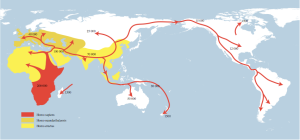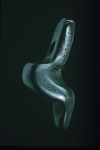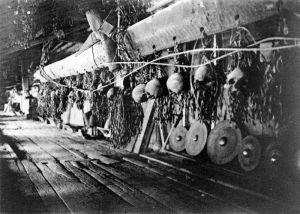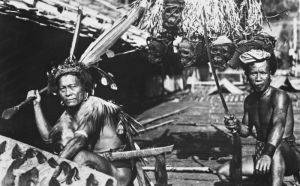Defining exactly who is white is contentious and difficult–so I shan’t. If you want to debate among yourselves whether or not the Irish or Hindus count, that’s your own business.
Here’s Haak et al’s full graph of human genomes from around the world, (see here and here for various discussions.) The genomes on the far left are ancient European skeletons; everything from the “pink” section onward is modern. The “African” genomes all have bright blue at their bottoms; Asian (and American Indian) genomes all have yellow. The European countries tend to have a triple-color profile, reflecting their recent (evolutionarily speaking) mix of European hunter-gatherers (dark blue), Middle Eastern farmers (orange), and a “teal” group that came in with the Indo-European speakers, but whose origins we have yet to uncover:
Unsurprisingly, the Basque have less of this “teal.” Middle Easterners, as you can see, are quite similar genetically, but tend to have “purple” instead of “dark blue”
 Physically, of course, whites’ most distinctive feature is pale skin. They are also unique among human clades in their variety of hair and eye colors, ranging from dark to light, and tend to have wavy hair that is “oval” in cross-section. (Africans tend to have curly hair that is flat in cross section, and Asians tend to have straight hair that is cylindrical in cross section. See map for more hair details.)
Physically, of course, whites’ most distinctive feature is pale skin. They are also unique among human clades in their variety of hair and eye colors, ranging from dark to light, and tend to have wavy hair that is “oval” in cross-section. (Africans tend to have curly hair that is flat in cross section, and Asians tend to have straight hair that is cylindrical in cross section. See map for more hair details.)
There are other traits–the Wikipedia page on “Caucasian race” (not exactly synonymous with “whites”) notes:
According to George W. Gill and other modern forensic anthropologists, physical traits of Caucasoid crania are generally distinct from those of the Mongoloid and Negroid races. They assert that they can identify a Caucasoid skull with an accuracy of up to 95% by the following features: [20][21][22][23][24]
- An orthognathic profile, with minimal protrusion of the lower part of the face (little or no prognathism).
- Retreating zygomatic bones (cheekbones), making the face look more “pointed”.
- Narrow nasal aperture, with a tear-shaped nasal cavity (nasal fossa).
 But I am not going to deal with any of these, unless I hear of something like the EDAR gene coding for a bunch of traits.
But I am not going to deal with any of these, unless I hear of something like the EDAR gene coding for a bunch of traits.
Old racial classifications made use of language groups as stand-ins for racial groups. This turns out to be not very reliable, as we’ve found that in many cases, a small group of conquerors has managed to impose its language without imposing its genetics, as you’ve discovered in real life if you’ve ever met an African or Indian who speaks English.
 The first known modern humans in Europe (IE, not Neanderthals nor Homo Erectuses,) popularly known as Cro-Magnons and unpopularly known as European early modern humans, (because anthropologists
The first known modern humans in Europe (IE, not Neanderthals nor Homo Erectuses,) popularly known as Cro-Magnons and unpopularly known as European early modern humans, (because anthropologists hate being understood dislike sounding like commoners,) lived around 43,ooo-45,000 years ago in Italy. By 41,000 years ago, Cro-Magnons had reached the southern coast of England.

(Incidentally, Mungo Man, found in south-east Australia, is also estimated to be about 40,000 years old, suggesting that either:
A. People took a much longer route from Africa to Europe than to Australia
B. Europe was difficult to enter when folks left Africa, possibly because of glaciers or Neanderthals
C. There were multiple Out-of-Africa events, or
D. Our knowledge is incomplete.
D is obviously true, and I favor C regardless of Mungo’s true age.)

These Cro-Magnons appear to have been brown skinned, brown eyed, and black haired–they likely looked more like their close relatives in the Middle East (whatever they looked like,) than their distant descendants in modern Europe. (Despite all of the mixing and conquering of the centuries, I think modern Europeans are partially descended from Cro-Magnons, but I could be wrong.)
The Cro-Magnons carved the famous “Venus of Willendorf” (we don’t really know if the figurine was intended as a “goddess” or a fertility figure or just a portrait of a local lady or what, but it’s a nice name,) among many other similar figurines, some of them quite stylized.



Some people think the figurines look African, with cornrows or peppercorn hair and steatopygia. Others suggest the figurines are wearing hats or braids, and point out that not all of them are fat or have large butts.
So when did Europeans acquire their modern appearances? Here’s what I’ve found so far:
Wikipedia states:
Variations in the KITL gene have been positively associated with about 20% of melanin concentration differences between African and non-African populations. One of the alleles of the gene has an 80% occurrence rate in Eurasian populations.[52][53] The ASIP gene has a 75–80% variation rate among Eurasian populations compared to 20–25% in African populations.[54] Variations in the SLC24A5 gene account for 20–25% of the variation between dark and light skinned populations of Africa,[55]and appear to have arisen as recently as within the last 10,000 years.[56] The Ala111Thr or rs1426654 polymorphism in the coding region of the SLC24A5 gene reaches fixation in Europe, but is found across the globe, particularly among populations in Northern Africa, the Horn of Africa, West Asia, Central Asia and South Asia.[57][58][59]
According to a team of researchers from Copenhagen University, a single mutation which arose as recently as 6-10,000 years ago was responsible for all the blue-eyed people alive on Earth today.
The team, whose research is published in the journal Human Genetics, identified a single mutation in a gene called OCA2, which arose by chance somewhere around the northwest coasts of the Black Sea in one single individual, about 8,000 years ago.
The hair color gene MC1R has at least seven variants in Europe giving the continent a wide range of hair and eye shades. Based on recent genetic research carried out at three Japanese universities, the date of the genetic mutation that resulted in blond hair in Europe has been isolated to about 11,000 years ago during the last ice age.[25] …
Recent archaeological and genetic study published in 2014 found that, seven “Scandinavian hunter-gatherers” found in 7700-year-old Motala archaeological site in southern Sweden had both light skin gene variants, SLC24A5 and SLC45A2, they also had a third gene, HERC2/OCA2, which causes blue eyes and also contribute to lighter skin and blond hair.[29] …
Genetic research published in 2014, 2015 and 2016 found that Yamnaya Proto-Indo-Europeans, who migrated to Europe in early bronze age were overwhelmingly dark-eyed (brown), dark-haired and had a skin colour that was moderately light, though somewhat darker than that of the average modern European.[49] While light pigmentation traits had already existed in pre-Indo-European Europeans (both farmers and hunter-gatherers) and long-standing philological attempts to correlate them with the arrival of Indo-Europeans from the steppes were misguided.[50] …
According to genetic studies, Yamnaya Proto-Indo-European migration to Europe lead to Corded Ware culture, where Yamnaya Proto-Indo-Europeans mixed with “Scandinavian hunter-gatherer” women who carried genetic alleles HERC2/OCA2, which causes combination of blue eyes and blond hair.[51][52][53] Descendants of this “Corded Ware admixture”, split from Corded Ware culture in every direction forming new branches of Indo-European tree, notably Proto-Greeks, Proto-Italio-Celtic, Proto-Indo-Iranians and Proto-Anatolians.[54] Proto-Indo-Iranians who split from Corded ware culture, formed Andronovo culture and are believed to have spread genetic alleles HERC2/OCA2 that causes blonde hair to parts of West Asia, Central Asia and South Asia.[52]
Genetic analysis in 2014 also found that Afanasevo culture which flourished in Altai Mountains were genetically identical to Yamnaya Proto-Indo-Europeans and that they did not carry genetic alleles for blonde hair or light eyes.[55][51][52] Afanasevo culture was later replaced by second wave of Indo-European invaders from Andronovo culture, who were product of Corded Ware admixture that took place in Europe, and carried genetic alleles that causes blond hair and light eyes.[55][51][52]
An interesting finding [in Ancient human genomes suggest three ancestral populations for present-day Europeans] is that the Luxembourg hunter-gatherer probably had blue eyes (like a Mesolithic La Brana Iberian, a paper on which seems to be in the works) but darker skin than the LBK farmer who had brown eyes but lighter skin. Raghavan et al. did not find light pigmentation in Mal’ta (but that was a very old sample), so with the exception of light eyes that seem established for Western European hunter-gatherers (and may have been “darker” in European steppe populations, but “lighter” in Bronze Age South Siberians?), the origin of depigmentation of many recent Europeans remains a mystery.
Beleza et al, in The Timing of Pigmentation Lightening in Europeans, write:
… we estimate that the onset of the sweep shared by Europeans and East Asians at KITLG occurred approximately 30,000 years ago, after the out-of-Africa migration, whereas the selective sweeps for the European-specific alleles at TYRP1, SLC24A5, and SLC45A2 started much later, within the last 11,000–19,000 years, well after the first migrations of modern humans into Europe.
And finally from Wikipedia:
In a 2015 study based on 230 ancient DNA samples, researchers traced the origins of several genetic adaptations found in Europe.[46] The original mesolithic hunter-gatherers were dark skinned and blue eyed.[46] The HERC2 and OCA2 variations for blue eyes are derived from the original mesolithic hunter-gatherers, and the genes were not found in the Yamna people.[46] The HERC2 variation for blue eyes first appears around 13,000 to 14,000 years ago in Italy and the Caucasus.[38]
The migration of the neolithic farmers into Europe brought along several new adaptations.[46] The variation for light skin color was introduced to Europe by the neolithic farmers.[46] After the arrival of the neolithic farmers, a SLC22A4 mutation was selected for, a mutation which probably arose to deal with ergothioneine deficiency but increases the risk of ulcerative colitis, celiac disease, and irritable bowel disease.
The genetic variations for lactose persistence and greater height came with the Yamna people.[46]
To sum:
Skin: 10,000 years, 11-19,000 years, possibly arriving after blue eyes
Blond hair: 11,000 years
Blue eyes: 6-10,000 years ago, 13,000 to 14,000 years ago














